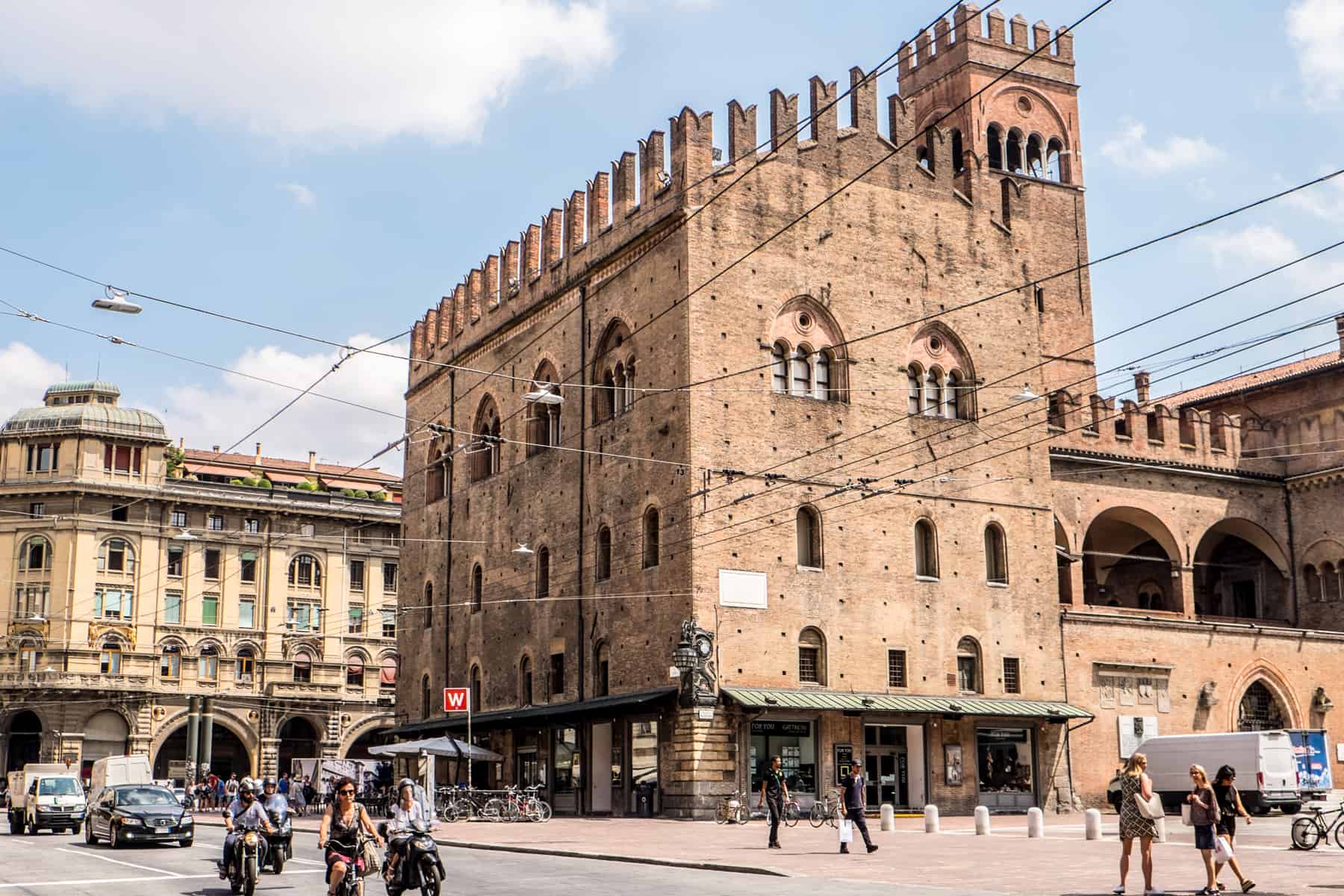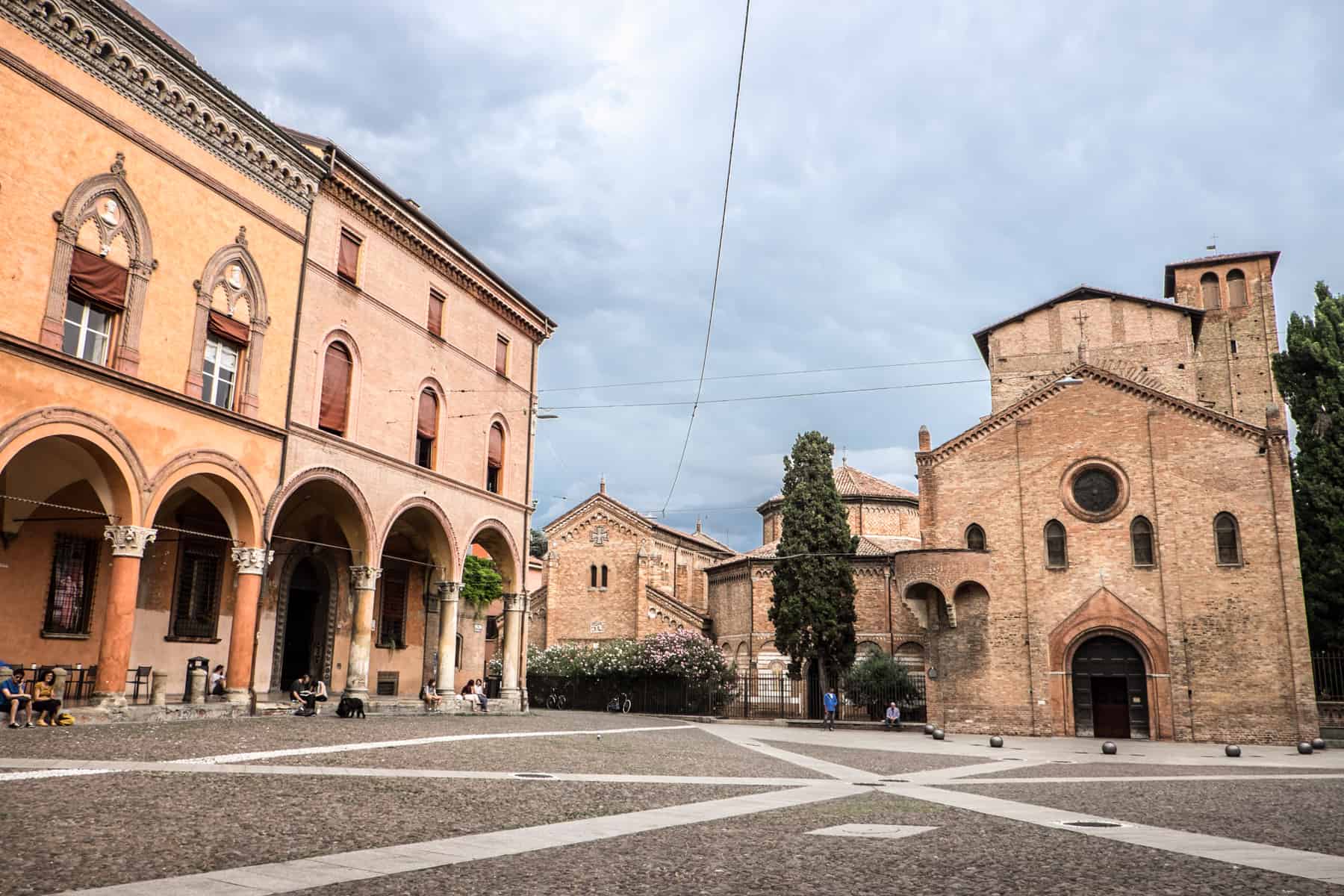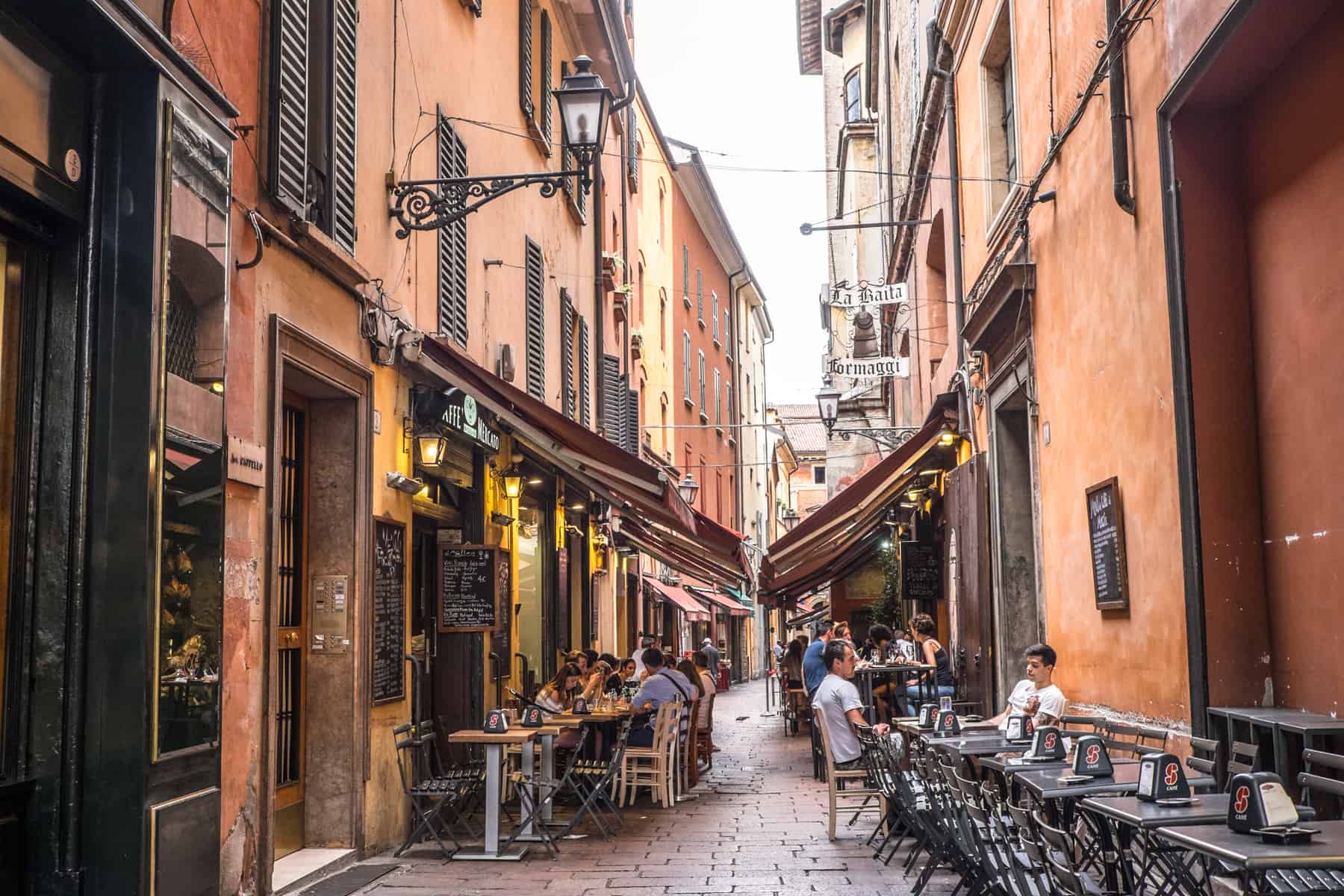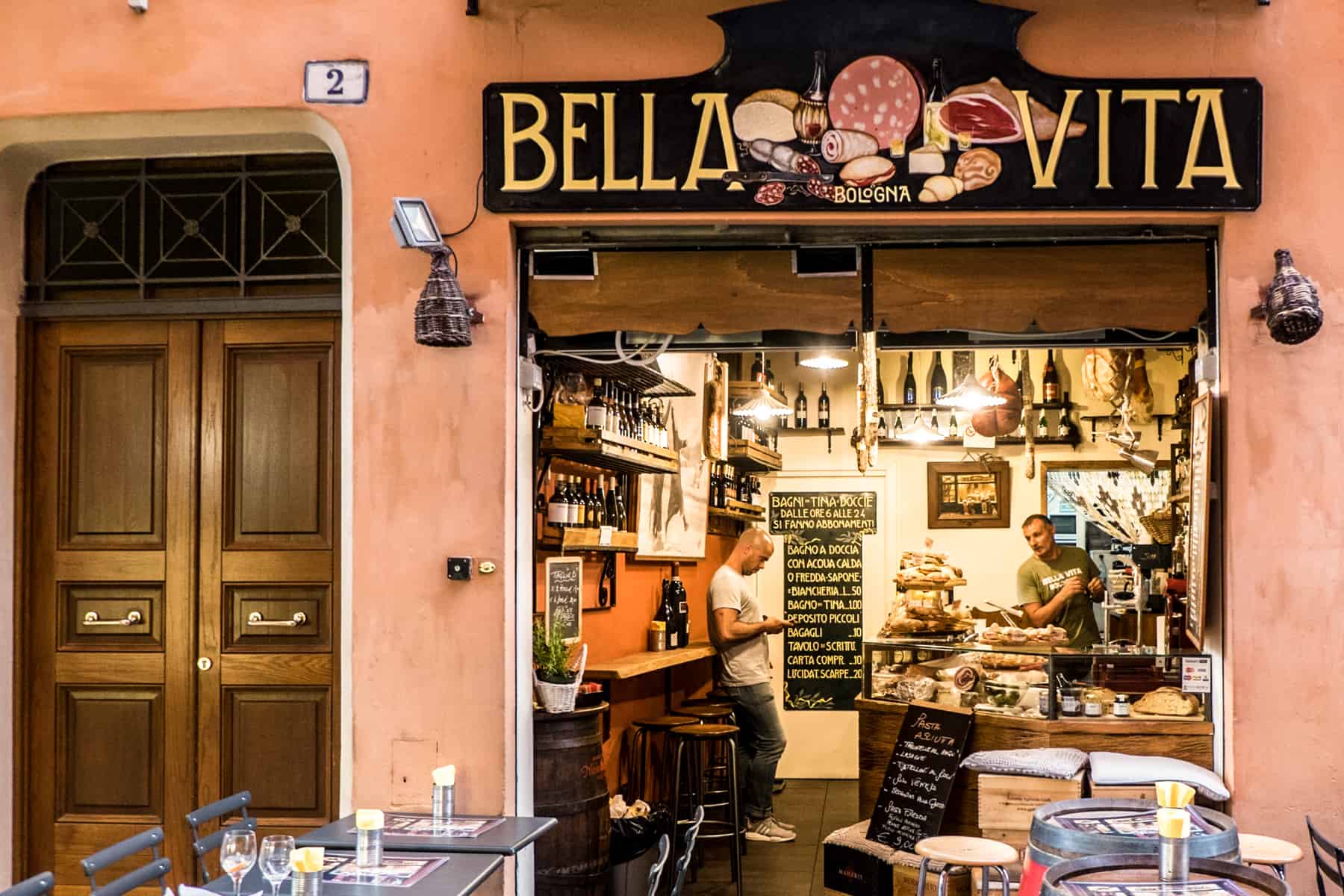Disclaimer: This post contains affiliate links to handpicked partners, including tours, gear and booking sites. If you click through or buy something via one of them, I may receive a small commission. This is at no extra cost to you and allows this site to keep running.
When you visit Bologna, you’ll see that it is everything cultural and culinary that you think of when it comes to visiting northern Italy, except its charm is in remaining lesser-known.
Wedged in between the country’s more established and well-trodden cities of Venice, Milan and Florence, travel to Bologna is often bypassed. Yet, it is Italy’s seventh-largest city and the historical capital and hearty food epicentre of the northern Emilia-Romagna region.
Lose yourself in the wide grid of elegant architecture and gritty side streets, food markets and coffee shops, crumbling historical houses and defining towers. Live locally and give yourself more time than the average one to two-day trip normally afforded, and you’ll have the perfect Bologna itinerary and immersion in the city.
Want to know what to expect? Here’s everything you need to know before you visit Bologna.

What to Do When You Visit Bologna – Italy’s Best Kept Secret
Contents
- Bologna Is a Medieval Maze
- Bologna Has the Oldest University in the World
- Bologna Is a City of Towers
- Bologna Is Gritty and Contemporary
- Bologna’s Porticos Conceal Another Layer
- Bologna Is Every Shade of Orange Pantone
- Bologna Is the Centre of Italian Cuisine
- Bologna Is Full of Elevated Viewpoints
- Bologna Is a Miniature Venice
- Bologna Is the Base to Explore Emilia Romagna
- Bologna Travel Tips
- Planning to Visit Bologna? Pin It!
Bologna Is a Medieval Maze
The living history of Bologna is layered in every block and street corner you cross. Every building intersection that forms part of a historical maze showcases the city’s medieval origins and Renaissance re-touches.
Old and beautiful, gritty and vibrant in equal parts, Bologna sightseeing makes for curious, long wanders. The compact maze of ancient streets is the heart of Bologna tourism and why people immediately become enchanted with the city.
The three connecting open squares are the very core of the action. Start at Piazza Nettuno, home of the cultural centrepiece of the Salaborsa Library and the symbolic Fountain of Neptune.

The entrance to Bologna’s Piazza Nettuno.

Outside the Sala Borsa Library in Piazza Nettuno, Bologna.
Full of colonnades, cafes, and pretty Palazzos, it’s at Piazza Maggiore where you will find the famed Renaissance beauty that is the Basilica di San Petronio that has the largest sundial in the world and Palazzo D’Accursio – the Town Hall and where you can gaze at the City Art Collection.

The Basilica of San Petronio in Piazza Maggiore, Bologna.

Renaissance architecture fills Bologna’s Piazza Maggiore, mixing with the medieval.
Walk along Via Santo Stefano and reach Piazza Santo Stefano. It’s symbolic as the square of “Seven Churches” with the Basilica of Santo Stefano at the helm, and surrounded by a cluster of 16th-century grandeur residences, including Palazzo Bolognini Isolani and the 16th century Palazzo Bolognini Amorini Salina.

Follow the lines in Bologna’s Piazza Santo Stefano and explore the square of “Seven Churches”.

Daily life in the historical Piazza Santo Stefano, Bologna.
Book Bologna Walking Tours
From €27 per person.
- Bologna city two-hour walking tour covering the highlights.
- A private tour of Bologna with a local guide.
- A guided three-hour walking tour of Bologna’s attractions.
For more secluded streets in your time, I recommend heading south of the Piazzas, west of via d’Azeglio. I enjoyed the architecture and was hoping that the Chiesa Della Santa church was open, to see the mummified relic of St. Catherine which sits on a golden throne. The spoiler is it’s rarely, if at all, open.
Bologna Has the Oldest University in the World
The oldest university in the world is in Bologna and it’s still in operation today. Alma Mater Studiorum is the oldest University in the western hemisphere and the oldest in Europe, established in 1088. Look out for Palazzo dell’Archiginnasio, marking Bologna’s stamp on higher learning.

Alma Mater Studiorum, the oldest University in the world, is in Bologna.
Bologna Is a City of Towers
Head west along via Rizzoli and you will find impressive the medieval towers that have come to symbolise the city. The two towers of Bologna – locally known as Le Due Torri – are a major attraction in Bologna since they are the last of what was once an original cluster of over 100 in the city’s medieval days.
The twin towers you can visit today in Piazza di Porta Ravegnana were commissioned in the 11th-century by the Asinelli and Garisenda families – the tallest of twenty that sprout from the city’s historical complex. Climb the 498 steps of the Asinelli Tower (Torre degli Asinelli) for a city view from 97.2 meters high.
Book: Torre degli Asinelli ticket with food tasting included.

Visit Le Due Torri – the two towers of Bologna.

Dare to climb the 498 steps of the 97.2 meters high Asinelli Tower?
Bologna Is Gritty and Contemporary
For contrasting gritty street scenes, murals and the other half of Bologna’s persona, wander around the neighbourhood that was the former Jewish ghetto. It’s edgy, has a younger crowd, third-generation coffee shops, and sporadic street art that I can see booming on the grid-street walls over the coming years.
There’s a free two-hour street art bike tour dedicated to this expressive scene.

Find the street art in Bologna’s more gritty side streets.

Cafe culture and local hangouts in Bologna’s contemporary neighbourhoods.
Bologna’s Porticos Conceal Another Layer
When it comes to what to see in Bologna, it’s easy enough to say that every street and square is its own attraction. However, one of Bologna’s defining features is its endless rows of elegant porticos that hold up the upper layers of the city and which are seen as extensions to the houses themselves. You can’t help but come off the street to walk beneath them.
You’ll end up stepping a fair few metres of Bologna’s 40 kilometres of porticos, so beloved that they are on the tentative list for UNESCO World Heritage listing. Not only are these a shelter from the weather, but also they are a chance to walk through one of the city’s most beautiful architectural additions that were established first in the Middle Ages.

Sightseeing in Bologna also involves exploring its 40 kilometres of Porticos.
Some of the original wooden porticos can be found in the historical centre of the city on some of the older, uneven structures that stand out, but the more modern structures can be found everywhere. Because of a law passed in 1288, it was a rule that any new house in Bologna should be built with a portico. Where man and horse paced the street, one would stride from one site to another in style under the protection of the portico.

Roads and Porticos in Bologna.
If you want to say you’ve walked the longest portico in Europe at 3,796 metres long, find the one in Bologna that starts just outside the city walls and leads to the Sanctuary of the Madonna di San Luca on the top of the Colle della Guardia – a hilltop pilgrimage site of sorts in the city.
Bologna Is Every Shade of Orange Pantone
Blazy. Dusty. Vermillion. Flame. If you took an orange Pantone swatch with you to Bologna, you would no doubt find a building or wall that matches every shade. Want to know where to go in Bologna? Don’t follow a route or try to tick off a particular list of sites but instead be hypnotized by warm colours that make Bologna feel inviting, with its peeling layers of rustic charm.

The warming shades of Bologna.

Nearly every available wall in Bologna is ochre coated.

Bygone Bologna, like a sepia picture.

Colourful Bologna ablaze in orange.
Bologna Is the Centre of Italian Cuisine
Not many have heard of the Emilia Romagna region of Italy but would immediately recognise its well-known gastronomy specialities like Parmigiano-Reggiano cheese, Parma ham, balsamic vinegar and Bolognese sauce. All of this puts Bologna food right in the beating heart of the culinary scene. One of the main things to do in Bologna is to eat, sample, indulge and enjoy it.
Knowing where to eat in Bologna is a big deal because even you can easily visit the food areas that surround the city, you can just as easily indulge in these Italian delights in the foodie capital, exactly as they should be served.
For a bundle of the best food picks head to the Quadrilatero district, which is a giant food market. During the day it’s humming with the sound of al fresco diners, food stalls, friends gossiping over coffee and family-run restaurants. For a list of the best restaurants, especially those serving the best pasta dishes with award-winning chefs and restaurants with rotating menus, this Bologna food guide will have you covered. At sundown, it’s time to enjoy an Aperol Spritz or two in one of its many bars.

The tiny bakeries in Bologna with some of the tastiest treats.

Dine al fresco in Bologna – la dolce vita, the local way.

Local bars in Bologna, for local wine and food plate specialities.

Traditional food stores in Bologna.
A food theme park, aptly named ‘Eataly World’, opened in November 2017 to further carve out Bologna’s name as THE culinary capital of Italy with over 30 restaurants, a huge market and multimedia experiences with gastronomy learning at its core. Book your Eataly World Tickets here.
Book Bologna Food Tours
From €39 per person.
- Self-guided food tour with tasting vouchers.
- Bologna cooking class with a local chef.
- Home cooking experience and Bologna markets tour.
- Two-hour wine tasting in one of Bologna’s oldest Inns.
Bologna Is Full of Elevated Viewpoints
One of the most beautiful things to do in Bologna is to see the city from above and get a glimpse of what was once a Medieval Manhattan with even more towers than the ones still standing today.
The majority of cities have one defining viewpoint or lookout from which to admire a panorama or see the city in its entirety, and this is precisely what to do in Bologna after you’ve lost yourself in the beauty on the ground. While the Sanctuary of the Madonna of San Luca basilica church in Bologna is elevated, it doesn’t give the best views over the city. However, three other high spots do.
Viewpoint 1: The Terrazza Panoramica della Basilica di San Petronio (the terrace of the Basilica of San Petronio) is the best place for a panoramic view over the city from the very centre. If any construction is taking place then only half the terrace will be open, yet this does not impact on the half you can see, making it still worthy of entry.

The view of Bologna from the Terrazza Panoramica della Basilica di San Petronio.
Viewpoint 2: You can also climb the 97-metre high Asinelli Tower and its 498 wooden steps, for a bird’s eye view on Piazza Maggiore and around.
Viewpoint 3: If you want a wider perspective and the best view of all the famed towers in their varying heights, take a short hike up the Bolognese Hills in the south of the city to the San Michele In Bosco (Srt. Michael in the woods) complex. My friend, Emiel from Act of Travelling captured this view when he was in Bologna with me. This church and convent complex has been re-mastered in design many times since the Middle Ages with a Renaissance façade addition and frescos from the 16th Century.
Bologna Is a Miniature Venice
The small underground canal that cuts through the city’s grid streets while remaining out of sight is one of the hidden things to do in Bologna. The city was once filled with open canals but they pushed underground over 200 years ago.
For a glimpse of what remains of this little Venice, you have to find the very small window that looks out onto one side of the canal the runs under Via Piella. Turn around and you will see a low wall that marks another viewpoint.

The window to the Bologna Canal on Via Piella.

A touch of Venice in Bologna?
Bologna Is the Base to Explore Emilia Romagna
A Bologna trip is the chance to uncover various destinations in the Emilia Romagna region of Italy and learn about its history. Once you are in the city, you are right in its epicentre, making day trips from Bologna as much a part of the experience as the city itself. With the Italian rail service serving all corners of the country, you can easily explore Emilia Romagna outside of its capital using Bologna as your base.
Visit Forlimpopoli, especially for the Festa Artusiana food festival.
Travel to San Marino and visit the oldest Republic in the world.
Head to the Palma Food Valley to not only admire the landscape which is prime ground for the region’s famed food produce, but to learn about the history of pre-united Italy from the rooms and terraces of Torrechiara Castle. Such fortified structures stand in testament to the times after the fall of the Roman Empire, when a pre-united Italy and its former stand-alone provinces were constantly under siege and occupation.

Visit Torrechiara Castle and learn about the history of Italy before it was a unified country.

Historical highlights intertwined with food.
At the base of Castello Di Torrechiara is Lamoretti – a part of the region’s famous food valley status, whose 22 hectares produce the best Malvasia wine and the perfect pairing with one of the area’s darling culinary specialities, Prosciutto De Palma. They say only Palma wines match the gastronomy, so being right here in the heart of it all is true perfection. The castle fortress view just adds to the cultural-culinary magical mix.

Lamoretti vineyard – for wines best paired with the region’s famed Prosciutto De Palma.
Go to the neighbouring province of Piacenza, known for the Rivalta Castle – a medieval stronghold and now a private residence open all year round for tours. It even has a number of bedrooms for those wanting to indulge in its legacy.

Visit the Rivalta Castle in Piacenza.
A historical hotspot and food valley haven, it’s surprising the places to visit in Bologna remain little known. Its preservation of the old and traditional Italy that everyone seeks is what makes it such a wonderful experience when you finally stumble upon it.
Bologna Travel Tips
Getting to Bologna, Italy
Flights to Bologna
From Bologna’s International Airport – Guglielmo Marconi Airport (BLQ) – you can either take a taxi into Bologna city centre (around €15) or use the Aerobus shuttle bus service that connects the airport and the main railway station. It runs every 11 minutes in both directions, and costs €6 per person. The first departure from the airport is at 5:30 am and the last at 12:15 am.
Bologna by Train
The Italian city of Bologna is accessible via the Italia Rail as well as being the main station from which to easily travel to regional areas and neighbouring cities. Timetables and ticket bookings can be found on the Italia Rail website, although it’s easy to buy tickets for shorter journeys directly at the station. ALWAYS remember to validate your ticket (via the ‘stamp’ machines) before boarding.
From the train station, the very centre of Bologna city can be reached in approximately 15 minutes on foot.
Bologna train station is also a great hub to access other Italy regions. Enjoy all the things to do in Perugia, head further south of Emilia Romagna to the picturesque capital of Umbria in 2.5 hours, or head north to Verona and Venice to visit the Veneto region.
Getting Around Bologna
Bologna is a walkable city, and you are never more than 30 minutes to key points of interest. It’s an enjoyable place to explore on foot but the city does have a great bus system, TPER (Trasporto Passeggeri Emilia Romagna). Various lines cover the city centre and the suburban areas, making it an easier way of getting around Bologna if you need.
There’s also a new tourist bus service – the City Red Bus – an open-top journey through Bologna’s main monuments and attractions.
The Best Time to Visit Bologna
July and August are the high summer months, where the weather in Bologna is at its warmest, but can be stifling hot and may make long days uncomfortable.
The best time for visiting Bologna is in May to June and September and October – the shoulder seasons on either side of summer and the optimal months for dry, warm weather and perfect al fresco temperatures.
Where to Stay in Bologna – Living Local
There’s an abundance of Bologna accommodation, with prices getting cheaper as you stay on the fringes of the city centre. I’ve always stayed in Bologna apartment rentals, like the modern Ugo Bassi Apartments, and family-run establishments like the gorgeous L’8Boutique apartments.
Locals Francesca and Federica decided to renovate their grandparents’ home where they spent much of their childhood, transforming it into stylish, beautiful living spaces for people travelling to Bologna. Their goal is for everyone to not only spend time in the city but experience real Bolognese living too, just as I did. These eight carefully restored and spectacularly furnished apartments are located halfway between the train station and Piazza Maggiore and are perfect for those looking for personality and style beyond larger hotels, and who wish to connect one-on-one with Bologna locals. Prices start from just €60.

Local living in Bologna hotel, L’8Boutique.
Bologna Welcome Card
- Like any city card, the Bologna Welcome Card is a money saver if you are looking to go to a lot of top attractions and museums. You can buy a €20 card with free entrance to listed museums and places of interest for 48 hours or a €30 card, which gives you access for 72 hours.
Further Reading on Bologna Travel
- Those wanting to dig deeper into daily life in Bologna and its hidden corners should consider the storytelling and illustrated travel guide to Bologna: Bologna Reflections – An Uncommon Guide.



Enrico says
I am a native from Bologna but I have been living in Malta for the past 5 years. I think this article about Bologna is absolutely lovely and, from my point of view as a person who was born and raised there, you covered nicely most of the notorious aspects of Bologna and some of the other areas in the region.
However, I would also recommend something for motorsports enthusiasts, as Bologna is home to Ducati, one of the most notorious motorcycle factories and motor racing teams for Moto GP, as there is the Ducati Museum in Borgo Panigale, a 15 minutes bus ride from the city centre with bus number 13 from either Via Farini, Piazza Malpighi or Via Lame. Moreover, in the town of Imola, 35 km away from Bologna, there is the Formula 1 Circuit which, although no longer hosting Formula 1 races, still hosts racing competitions and concerts.
If you are ever to return to Bologna, I would suggest you visit the Regional Historical Park of Montesole, near the Etruscan ruins of Marzabotto, which acts as a memorial for the Second World War Massacres; or the Monteveglio Abbey, which is a perfect example of medieval fortified monastical complex with a lovely natural landscape surrounding
Becki says
Thank you, Enrico. And also for those extra local tips. I’m aware of the moto attractions – I’ve just never tried it! I think Regional Historical Park of Montesole would be next on my list though.
Enrico Monti says
I went there 9 years ago for a school trip for our awareness about the historical role of Montesole, due to the remains of several hamlets being what was left by the largest scale nazi genocide carried out in the whole of Italy. The entrance to the park is just across the Reno River opposite Marzabotto’s railway station. Other than that there are other entrances at Pian di Venola’s Railway Station or in Vado, a short walk away from Monzuno-Vado railway station, on the eastern side of the park, as it takes less time
Becki says
Really interesting – thank you!
Ben Zweber says
Indeed. Bologna is Italy’s best-kept secret. You took some amazing photos! Thank you for sharing. All in all, how much did you spend for the whole four-day trip?
Becki says
I’d say €30 – €50 a day. It depends on how much you want to eat and where. Plus all the food you buy to take home.